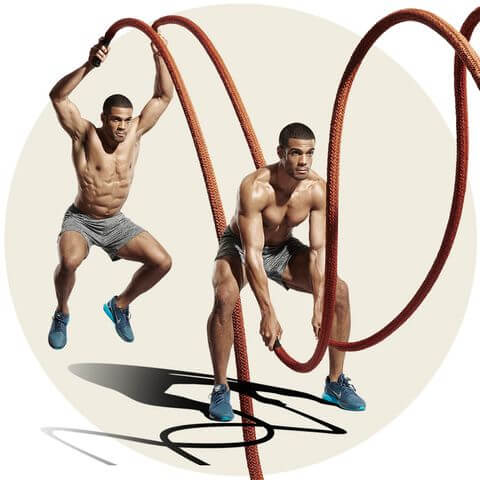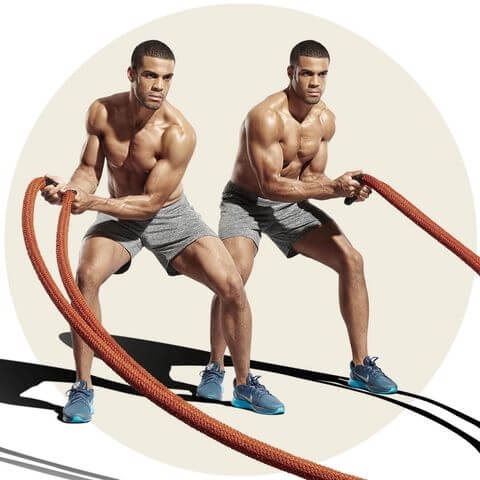Battle ropes have become ubiquitous in gyms around the world—CrossFit boxes, personal training boutiques, bootcamps, you name it.
If you’d asked someone what a “battle rope” was 10 to 15 years ago, though, they probably would have thought you were referring to some piece of military hardware.
So, why have battle ropes become so popular?
Simple—they’re a fun and effective way to build muscle, strength, and endurance (and burn a shedload of calories in the process).
In this article you’ll learn everything you need to know about battle ropes training, including what battle ropes are, the benefits of battle ropes, the muscles worked by battle ropes, the best battle ropes exercises, and a sample battle ropes workout.
- What Are Battle Ropes?
- What Are the Benefits of Battle Ropes?
- 1. They improve endurance.
- 2. They build muscle.
- 3. They increase strength.
- What Muscles Do Battle Ropes Work?
- The Best Battle Ropes Exercises
- 1. Double-Arm Slams
- 2. Alternating Single-Arm Waves
- 3. Side to Side Waves
- 4. Double Outside Circles
- 5. In and Out Waves
- A Sample Battle Ropes Workout
- FAQ #1: What are the best battle ropes for sale?
- FAQ #2: How do you anchor battle ropes?
- FAQ #3: How do you make your own battle ropes?
Table of Contents
What Are Battle Ropes?
Battle ropes—also known as battling ropes or heavy ropes—are a strength and conditioning tool primarily used for improving cardiovascular fitness. They’re typically made of heavy braided plastic thread, are 1.5-to-2 inches thick, 30-to-50 feet long, and weigh 15-to-50 pounds. The longer, thicker, and heavier the rope, the more physically demanding it is to use.
Although the name is plural, battle ropes are actually just one rope that’s anchored (normally to the floor or a wall) in the middle. This effectively creates two ropes that originate from the same point, but that can be manipulated independently.
A battle ropes workout typically consists of whipping, slamming, swinging, and dragging the ropes in a variety of ways, often in bouts of high intensity, followed by periods of rest (like other HIIT-style workouts).
Want a free custom meal planning tool?
Quickly calculate your calories, macros, and even micros for losing fat and building muscle.

What Are the Benefits of Battle Ropes?
As with most exercise equipment, there isn’t much research on battle ropes, but it’s fair to assume they’ll offer similar benefits to other forms of high-intensity cardio.
Here are the highlights.
1. They improve endurance.
VO2 max refers to the maximum amount of oxygen your body can use while you workout.
Increasing your body’s capacity to use oxygen is a guaranteed way to improve your endurance—a higher VO2 max delays the point at which you feel like you have to stop exercising.
Several studies show that battling ropes training is an effective way to increase your VO2 max.
What’s more, in one study conducted by scientists at the University of Taipei, researchers found that battle ropes training was more effective at improving endurance than shuttle run training (and carried a smaller risk of injury), and was highly effective at improving core muscle endurance (which enhances athletic performance and may reduce injury risk).
2. They build muscle.
As a rule, aerobic training isn’t effective for building muscle because it doesn’t create enough tension in your muscles to cause growth.
Research shows, however, that battling ropes training is an exception.
In a study conducted by scientists at the University of Wisconsin-La Crosse, researchers compared muscle activation (not exactly the same as measuring tension, but a decent proxy) in the vastus medialis, gluteus maximus, erector spinae, external oblique, rectus abdominis, upper trapezius, anterior deltoid, and palmaris longus during five battle ropes exercises.
Results showed that with only a few exceptions, all the muscles measured were active enough during each exercise to cause hypertrophy, with the “double-arm slam” exercise proving particularly effective for training all the muscles measured.
Basically, battle rope workouts blur the line between weightlifting and cardio, giving you some of the benefits of both styles of training.
3. They increase strength.
If you stop getting stronger, your muscles will eventually stop getting bigger.
That’s why you should strive to increase the intensity of your workouts over time. This is known as progressive overload, and it’s one of the best ways to maximize the muscle-building effects of exercise.
The best way to achieve progressive overload is to simply lift more weight, and battle ropes make this a cinch.
Because battle ropes come in a range of lengths and thicknesses, you can make your battle ropes workouts progressively more difficult, which is why research shows they’re effective at helping you build strength.
For example, in one study conducted by scientists at the University of Windsor, researchers had participants increase the weight of the rope they used halfway through a six-week battle ropes training program, and the final results showed that . . .
- Male and female participants increased the number or push-ups they could do by 16% and 27%.
- Male and female participants increased the number of sit-ups they could do by 19% and 23%.
- Male participants increased shoulder flexion strength by 7%.
- Female participants increase shoulder flexion strength by ~10% and shoulder extension strength by ~15%.
- Male and female participants increased shoulder power (measured by throwing a medicine ball into a force plate) by 15% and 17% respectively.
What Muscles Do Battle Ropes Work?
Studies show that the main muscles worked by battle ropes are the . . .
In other words, battle ropes give you a total body workout.
The Best Battle Ropes Exercises
The best way to learn how to use battle ropes is to learn how to do the best battle ropes exercises. While you can find many battle rope exercises (and come up with your own!), here are a few favorites.
1. Double-Arm Slams

- Hold one end of the rope in each hand about a foot in front of your navel and get into a quarter squat with your feet shoulder-width apart.
- Jump off the floor and whip the ends of the rope toward the ceiling until your arms are overhead.
- As you land, slam the rope into the floor as hard as you can.
- Repeat the movement for the desired length of time.
2. Alternating Single-Arm Waves

- Hold one end of the rope in each hand about a foot in front of your navel and get into a quarter squat with your feet shoulder-width apart.
- Quickly raise your right hand toward the ceiling until it reaches eye level, then, with a whipping motion, slam the rope into the floor by moving your right hand quickly downward (this should create a “wave” in the rope).
- Without pausing, repeat the movement on your left side.
- Continue to alternate between your left and right side for the desired length of time.
3. Side to Side Waves

- Hold one end of the rope in each hand about a foot in front of your navel and get into a quarter squat with your feet shoulder-width apart.
- Quickly twist your torso to the right, whipping the rope with you.
- Without pausing, twist your torso sharply to the left, whipping the rope with you.
- Repeat the movement, alternating side to side, for the desired length of time.
4. Double Outside Circles

- Hold one end of the rope in each hand about a foot in front of your navel and get into a quarter squat with your feet shoulder-width apart.
- With your hands close together, quickly lift the ends of the rope toward the ceiling until they reach eye level.
- Whip both ends of the rope downward and outward in circles, until your hands meet about a foot in front of your navel.
- Repeat the movement for the desired length of time.
5. In and Out Waves

- Hold one end of the rope in each hand about a foot in front of your navel and get into a quarter squat with your feet shoulder-width apart.
- Quickly move your arms so that they’re directly out to your sides, whipping the rope with you.
- Sharply bring both ends of the rope back to the starting position.
- Repeat the movement for the desired length of time.
A Sample Battle Ropes Workout
If you’re new to battling ropes training, this is a great workout to get you started.
Repeat the circuit three times for a total of 20 minutes of exercise.
- Double-Arm Slams: 20 sec at 90% of your max effort then 1 min rest.
- Alternating Single-Arm Waves: 20 sec at 90% of your max effort then 1 min rest.
- Side to Side Waves: 20 sec at 90% of your max effort then 1 min rest.
- Double Outside Circles: 20 sec at 90% of your max effort then 1 min rest.
- In and Out Waves: 20 sec at 90% of your max effort then 1 min rest.
If you want to kick the intensity up a notch, reduce your rest time to 40 seconds between exercises, or if you really want to push the envelope, use a 1:1 work to rest ratio—20 seconds on, then 20 seconds off.
FAQ #1: What are the best battle ropes for sale?
The best battle rope you can buy . . .
- Comes in a range of lengths and thicknesses so you can find an appropriate rope for your fitness level
- Has a cover so that it can be used indoors and outdoors
- Has handles so that it’s easy to grip during your workouts
. . . which is why the GEARDO Battle Rope is a solid choice for your home gym.
Or, if you want something a little less expensive, check out the Amazon Basics Battle Rope. Finally, if you want to ball out on your battle rope, check out the Garage Fit Battle Ropes.
FAQ #2: How do you anchor battle ropes?
Some people say you can anchor a battle rope by passing the rope through the handle of a heavy kettlebell, but I don’t recommend this as it can be unstable.
The best solution is to buy a battle rope hook which can be attached to a wall with nuts and bolts, or a battle rope anchor strap that can be wrapped around a heavy object like a squat rack. Or, you can buy some nylon webbing that you can use to tie the battle rope to something heavy or fixed to the floor (like a squat rack, the bumper of a car, etc.).
FAQ #3: How do you make your own battle ropes?
To make your own DIY battle ropes, all you need is a rope that’s 30-to-50-foot long and 1.5-to-2 inches thick, and a roll of heavy-duty athletic tape that you can wrap around the ends as handles.
Bear in mind, though, that DIY battle ropes aren’t protected by a cover, so they’re more susceptible to fraying and they won’t be suitable for outdoor use.
The post The Beginner’s Guide to Battle Ropes: Benefits, Exercises & Workouts appeared first on Legion Athletics.

